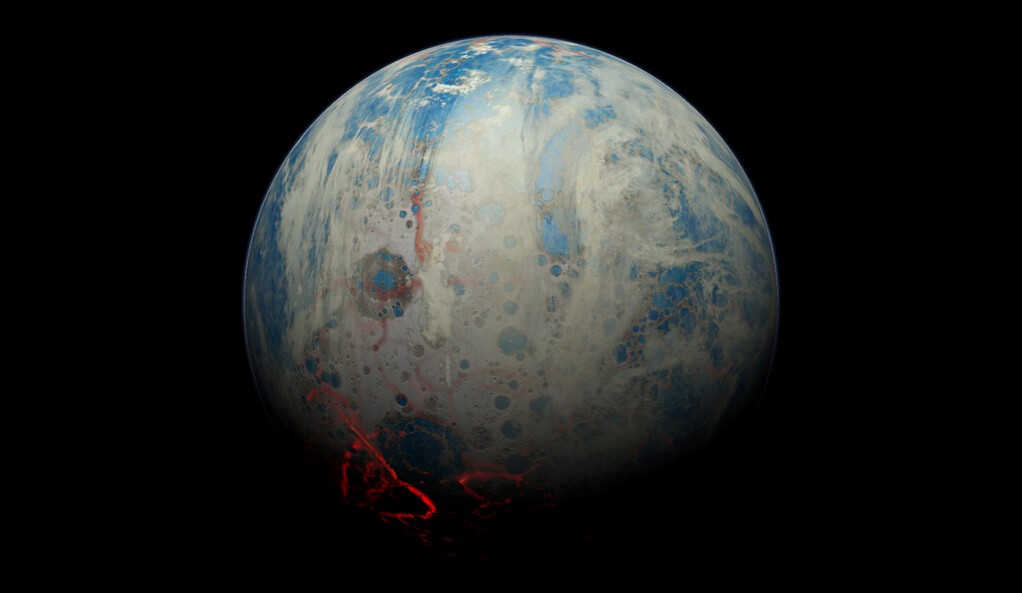Earth began with an atmosphere similar to that of Venus. While Venus continues to have a hellish surface, Earth turned into a habitable world within just 100-200 million years. How was that possible? We proposed a scenario using theoretical modeling, where a peculiar type of rock that is currently extinct on Earth could have triggered such a radical change.
Views 6038
Reading time 4 min
published on May 19, 2023
No terrestrial rocks that formed in the first 500 million years of Earth’s history have been discovered so far, making it difficult to study this period. This, however, has not deterred scientists from trying to understand this period because many events that shaped the present-day Earth occurred back then. One of them is the “Moon-forming Giant Impact.” Earth was hit by a Mars-size body, and the cataclysmic impact produced oceans of magma.
An enormous amount of carbon dioxide (CO2) was released into the atmosphere from the magma after the giant impact; its amount is estimated to be at least 2000 times the modern CO2 level. Its extreme greenhouse effect kept Earth’s surface far from habitable even after the magma solidified. Fittingly, this first geological period is called the Hadean, named after Hades, the Greek god of the underworld. Modern-day scientists associated Hades with the hellish world that prevailed during the beginning of Earth’s evolution.
The view of the hellish environment, however, has changed during the past twenty years with the discovery of zircons created in the Hadean. Zircons are an extremely durable mineral, and Hadean zircons have managed to survive more than 4 billion years of tectonic activities. These zircons are enriched in heavy oxygen and yield low melting temperatures. Such features are most naturally explained if surface water already existed at the time of their formation.
Hadean zircons also point to a tectonic environment similar to the present-day subduction system, so the Earth’s surface probably looked more like the current situation than we originally imagined. The Hadean zircons date back to 4.35 billion years ago, whereas the giant impact took place around 4.5 billion years ago. This means that the transformation of a hellish environment into a clement water ocean world happened just within 100-200 million years, which is short in terms of geologic time.
The Hadean has thus experienced the most dynamic time in the Earth’s history, and active tectonic activities during the Hadean are considered to have driven the rapid change in the surface environment. When new seafloors are produced at mid-ocean ridges and then recycled back to the interior, CO2 in the atmosphere is dragged down together with ocean basins. Carbonates, CO2-bearing minerals, can form within the seafloor, and their subduction removes CO2 from the atmosphere.
The speed of this CO2 draw-down by plate tectonics, however, was not well known for the early Earth. When the mantle melts beneath mid-ocean ridges, it loses water and stiffens, and because of this so-called dehydration stiffening, the vigor of mantle convection is considered to be kept similar regardless of the mantle temperature. Geological data also suggest that plate velocity has remained roughly the same for the past 3-4 billion years. Extrapolating such a trend implies that plate velocity in the Hadean was not any faster than modern times.
If the Hadean plate velocity had been the same as in modern times, the surface temperature would have been higher than 200 °C for longer than 1.5 billion years. Such a long-lasting Venus-like climate disagrees with geological records, so we were compelled to explain what could have been different in the Hadean. We proposed that the unique composition of the Hadean rocks could be a solution to this problem.
We compiled models of petrology, heat transport, and atmospheric physics. By modeling how the magma ocean solidifies, we found that most of the Hadean mantle may have been extremely enriched in magnesium, with a concentration level seldom observed in present-day rocks. We discovered that that such a peculiar kind of rock would not stiffen upon melting as much as modern-day rocks, thereby being able to speed up the plate motion in the Hadean to 50 cm/yr. With a velocity 10 times faster than the current plates, our results explain how a massive CO2 atmosphere would have been sequestered to the interior within a mere 160 million years.
In addition, this weird rock would be highly reactive with seawater and generate a large flux of hydrogen. Such a reduced gas is believed to be critical for the emergence of primordial life. We realized that similar water-rock reactions are seen in a rare type of modern deep-sea vent called the Lost City hydrothermal field. In Lost City, microbes living off of hydrogen and methane are known to form an underwater community under a moderate temperature. Had the early Earth been covered by this weird type of rock supported by our modeling, an ideal condition for early life may have been globally available on the Earth’s surface.
Original Article:
Miyazaki, Y., & Korenaga, J. (2022). A wet heterogeneous mantle creates a habitable world in the Hadean. Nature, 603(7899), 86–90. https://doi.org/10.1038/s41586-021-04371-9
 Earth & Space
Earth & Space



